
The Best of Everything
Encyclopedia Entry • Films Main
The Bride Wore Red
1937

Critics' Reviews • Our Reviews • Movie Posters • Lobby Cards • Misc. Images
Click here to see photos from the film.
US general release: 10/8/37.
VHS release: 6/24/92. DVD on-demand release from Warner Archives: 3/4/14. Cast: Joan Crawford (as "Anni"), Franchot Tone, Robert Young, Billie Burke, Reginald Owen, Lynne Carver, George Zucco, Mary Phillips, Paul Porcasi, Dickie Moore, Frank Puglia. Credits: Based on the unproduced play "The Girl from Trieste" by Ferenc Molnar. Screenplay: Tess Slesinger and Bradbury Foote. Producer: Joseph L. Mankiewicz. Director: Dorothy Arzner. Camera: George Folsey. Art Director: Cedric Gibbons. Music: Franz Waxman. Costumes: Adrian. Editor: Adrienne Fazan.
Plot Summary: Based on The Bride from Trieste by Ferenc Molnar, The Bride Wore Red stars Joan Crawford as the eponymous heroine. A singer in a seedy Budapest dive, Anni (Crawford) is mistaken for a socialite thanks to a practical joke perpetrated by the cynical Count Armalia (George Zucco). Though a bit confused about her new favored status, Anni happily hobnobs with the "best people" on the Tyrol, including handsome Rudi Pal (Robert Young), who falls in love with her. She manages to pull off her charade for two full weeks, at which time the Count callously reveals the truth. Rudi Pal gallantly offers to marry Anni anyway, but she settles for a happier -- if less financially advantageous -- union with humble village postman Guilio (Franchot Tone, Crawford's husband at the time). When all is said and done, The Bride Wore Red is essentially a showcase for MGM's wardrobe department, with Joan Crawford garbed in a variety of gorgeous gowns, each one more dazzling than the last. ~ Hal Erickson, All Movie Guide
Notes:
|
Howard Barnes in the New York Herald Tribune: Joan Crawford has a glamorous field day in The Bride Wore Red.... With a new hair-do and more wide-eyed than ever, she plays at being a slattern, a fine lady, and a peasant with all of the well-known Crawford sorcery. It is not entirely her fault that she always remains herself. [The film] has no dramatic conviction and little of the comic flavor that might have made it amusing though slight. Your enjoyment of it will depend on how much of Miss Crawford you can take at one stretch.... The direction of Dorothy Arzner is always interesting and sometimes...is extraordinarily imaginative, but here she has not been able to give a vapid Cinderella pipe dream more than a handsome pictorial front.
Frank S. Nugent in the New York Times: Gowns by Adrian and settings by Cedric Gibbons do not entirely conceal the underlying shabbiness of The Bride Wore Red, one of those seasonal discoveries of Cinderella which Metro-Goldwyn-Mayer turned into the Capitol yesterday. Now it has Miss Joan Crawford who puts on an emotional circus as the shoddy cabaret girl (with dreams) who has been given two glorious weeks with high society in the Tyrol and tries desperately to have the clock stopped before her witching hour strikes.... If anything at all, it is a woman's picture--smouldering with its heroine's indecision and consumed with talk of love and fashions. Tall talk, mostly.
|
If you've seen The Bride Wore Red and would like to share your review here, please e-mail me. Include a photo of yourself or avatar to accompany your review, a star-rating (with 5 stars the best), and any of your favorite lines from the film.
Rating:
The Bride Wore Red, 1937, is a story as old as Hollywood. Older. From Cinderella to My Fair Lady to Pretty Woman and beyond, cinema has long obsessed with the contrast between haves and have nots, and sought to entertain movie-goers with drama arising from characters seeing how the other half lives. For TBWR, not surprisingly, Joan is the girl from the other side of the tracks: Anni, a chanteuse in a dive bar in Trieste. For two weeks she gets to pretend to be a wealthy woman of impeccable breeding. If you’ve seen any of a thousand movies with this plot, you know how it’ll go. There are a few nice twists though, in particular as Joan struggles with her conflicting goals of love and wealth. Despite a cliched theme and the fact that this movie may have marked the point of “¡No Mas!” for Joan’s fans re the “Cinderella in Adrian gowns” phase of her career, there are points of interest that I think fans of Joan will enjoy. First: She is gorgeous and a real feast for the eyes! They tried to cover her up with oversized flowers, a veil, garland, etc., but she’s stunning regardless of accoutrements. (I find myself also obsessing over Joan’s coiffures lately. In this movie she wears her hair straight. I think it’s called a page-boy hairdo, but without bangs.) If you’re a fan of Billie Burke, and want to see her as something other than a ditzy socialite, then this is your movie. Here, Burke is a socialite, but not ditzy. She’s Joan’s antagonist, and it is nice to see her play against type. Joan Hubby # 2, Franchot Tone, is the male co-lead. (Tone, for some reason, bothers me in most of his movies. Maybe it’s just a bit of the green-eyed monster.) Here, he’s a backwoods philosopher and “have not” contender for Joan’s heart. Robert Young is the “have." Although already engaged, Young’s character, Rudi, is ogling Joan from the first moment he lays eyes on her. I can’t say I blame him, but bad form nonetheless for the future Marcus Welby, MD. Among the supporting cast, I thought Mary Phillips---the second of four Mrs. Humphrey Bogarts---as Maria stood out. Maria is a friend of Anni from her Trieste days, who by Tinsel Town coincidence happens to now be a maid at the swanky resort where Joan/Anni tries to pull off her subterfuge. Maria plays the role of Joan’s conscience as her character struggles to decide whether love is more important than money or vice versa. Further down the list of credits, two actors stood out to me: Paul Porcasi as the petty-tyrant owner of the hotel, and Frank Puglia, the kindly waiter, Alberto, who helps Joan negotiate the pinkies-out world of aristocrats. Reginald Owen and George Zucco are amusing in their limited screen time. If you blink you’ll miss Adriana Caselotti as a peasant girl. (Who? None other than the voice of Snow White in the landmark 1937 cartoon.) Now as for that red dress! The gown that Joan wore for the climactic scene is 3rd on my Joan tier list of gowns---after the Letty Lynton dress, and the gold number she wore in her final scene in The Women. Why MGM couldn’t spring for a short technicolor sequence to show it off, I have no idea! Here's a Reddit photo of the stunning dress in question: TBWR is directed by Dorothy Arzner, who finished up the directing of Joan’s previous film, The Last of Mrs. Cheyney (1937), when the original director died. Arnzer was a very rare female director in the sound era of the studio system. Although a pioneering female member of the Directors Guild of America, Arzner did not direct after 1943, and spent the last decades of her life teaching. Fortunately, as feminism grew, Arzner was rediscovered and received accolades during the last years of her life. All in, at 103 minutes, The Bride Wore Red moves along nicely. It may have been the film that soured Joan’s fans on her typecasting as a clothes-horse Cinderella. However, with 80+ years of hindsight, it remains an amusing entry in Joan’s body of work. Not her best, not her worst.
Rating:
Before re-watching this film and writing this review tonight, I hadn't seen "Bride" in over 15 years. I didn't remember much about it, other than "Joan falls in love with simple postman. And there's a glamorous beaded red dress involved." Unlike fellow reviewer Michael Lia's 2009 experience (see below review) while on cocaine/vodka/pot, I saw "Bride" tonight with only a couple of beers to accompany me---and it was still pretty darn good...and much better than I had remembered after watching it the first time.
One thing that I'd forgotten about Joan's film history: I'd erroneously had it in my head that, after 1930's Paid and 1932's Letty Lynton, Joan didn't play another truly ambiguous, semi-dark character until 1939's The Women. Nope. Despite the lightweight MGM run from '33 through '36 (Today We Live through Love on the Run), Joan's 1937 and 1938 pictures (Cheyney, Bride, Mannequin, Shining Hour) featured rather serious, complicated characters---lead-ins to her real break-through, diverse acting run from '39 to '41 in Women, Cargo, Susan, and Woman's Face.
In this "prequel" of sorts to her latter-day serious film career, Joan is Anni, a singer in a dive cabaret. A plot-point I'd forgotten from my much-earlier viewing: Prior to Anni's first appearance, a decadent Count (George Zucco) and his younger protege (Robert Young) are having a philosophical discussion in a ritzy casino about the only difference between a gentleman and a waiter being Luck. The Count thinks it's luck; Young thinks it's "breeding." The two then migrate to a local dive bar where Anni is singing; the proper Young goes home in relative disgust while the Count tests out his theory: He invites the club singer (Joan as "Anni," who's been warbling, with beautiful sad/bitter eyes, "Who Wants Love" amid the brawling, groping regulars) over to his table. He offers her food (her poor, hungry self asks for "stew, with lots of meat" rather than the caviar he initially presents) while condescendingly asking her about her background---a curiosity that she interestingly challenges as his wanting to watch animals in a zoo. As he learns, she's acquired her speech and manners from watching films portraying his kind of ladies: "stupid and artificial." Yet she then, disgusted with both him and herself, allows him to re-name her based on a beer sign on the wall (from her original "Pavlovich" to "Vivaldi") and offer her money to spend 2 weeks in a ritzy hotel, along with money to buy herself a full wardrobe---all in line with his theory that, given enough money, anyone could be turned into a lady.
This a great premise for a film---a la "My Fair Lady" or "Pretty Woman"---though not at all so feel-good or frothy as the more-recent iterations. Joan's bar-room Anni is pretty bitter at her past treatment in life, and honest with her potential 2-week benefactor: She doesn't like him, though she takes his money. And once she arrives in her new incarnation at her beautiful hotel residence for the next 2 weeks, she's utterly snobbish to the local postman (played by Joan's husband Franchot Tone, in their last film together) and, initially, to her maid---until she finds out that the maid had been a fellow bar-entertainer back in their home town!
There are plenty of interesting explorations
of class roles here:
The Count's goal, and Anni's, was to allow her to, in a wealthy environment, change her life. At the ritzy hotel, she initially catches the eye of Robert Young (as his Count mentor had planned according to his original intellectual premise), and Young does indeed fall in love with her. Oh, but wait: He only wants her for his mistress... Now here comes a scene that director Dorothy Arzner blew completely: This intense scene, which should have been along the lines of the famous Rain or Letty confrontation scenes, is filmed in a mild side/profile-shot with Young, instead of full-frontal Joan emoting. This would have been a great Joan scene: But I want you to love me. I want you to marry her, and I want my love to haunt you. To make you lie awake at night, to burn your heart, to make you sick with pain..."
Throughout the Joan/Anni dilemma of what/who to choose thumps along the Franchot Tone "Giulio/Postman" character. He represents all that's good and pure and bucolic. He's "good" in that he appreciates "nature," etc. And plays flute in a local band that the citified Robert Young disdains (in favor of night-club orchestras). But then Giulio/Postman can also be a complete jerk: for instance, when he hides a revealing telegram for part of the picture, ultimately revealing it at the end, to Anni's detriment. Not cool, Giulio, especially when comparing the onscreen kisses between Anni and Young's character, and Anni and Giulio---the former are passionate, the latter mild, despite Anni's avowals to get that pesky telegram out of Giulio's hands.
Joan is interesting to watch here. Her scenes with her maid, a former employee at the old bar, are honest and great, as is a funny moment when Anni receives a letter from the bar-owner from whom she's taken a 2-week leave: "Hey Anni... Sophie finally hit her husband with a lamp and she got 2 years hard labor...How are you getting on with the high hats?"
Rating:
This movie belongs in the same category as No More Ladies -- strange and probably a bad movie. But there is something about it that I like and find fascinating. It might be like an awful piece of artwork, but is there such a thing? At an art gallery you cannot use the word ”interesting,” but in films you can. This is an interesting film.
One day I did cocaine and vodka and some pot, and I watched The BrideWore Red. In my state of mind I found this to be as good as any movie I'd ever seen -- I mean really good! It was deep and scary and romantic and very intense. Miss Crawford looked intriguingly beautiful. The scenes she shares with real-life husband Franchot Tone are really quite believable, and their love story can be written for any up-and-coming actress in today’s life (we still want to make it and not work in a dump). This is a love story.
If the original script had stayed the same, it wouldn’t have worked because Crawford’s fans did not like when she stepped out too far! When Luise Rainer dropped out, the script was revamped for MGM's Cinderella. Dorothy Arzner, the director, did what she could with the material at hand. (But other than Craig’s Wife, name another movie of hers quickly!)
The cast has some of my favorites: Billie Burke in a nice, bitchy role. Reginald Owen, who played lots of fun characters, even a crack at Sherlock Holmes! He is engaging to watch. The little girlfriend was played by Lynn Carver, and she died sadly, quite early. (She appeared in the 1938 version of The Christmas Carol .) Mary Phillips needs credit as the hotel maid; she was once married to Bogart and lasted awhile doing character parts. (Look for her in Mannequin, as well; she is a little like Glenda Farrell.)
Robert Young: No wonder he drank in later years. He can play a mean guy, and when he plays a nice guy he still has an edge; you know he is all wrong for Miss Crawford, but she persists, and he plays along, and so does the script. He is definitely miscast.
Now, Mr. Franchot Tone I think did a fine piece of acting. I like him and I like his character and I would not mind his job. He seemed to know how everything was going to turn out, and he got the gal in the end! (I like men like that.)
A Bride Wore Red fun fact: Look for Ann Rutherford in a small bit as one of the peasant girls. She is still going strong today!
So, do what you have to do to get in the right frame of mind and watch this movie.
Susanne (September 2009) Rating:
Old Hollywood was always fabulous in using subtext, and this film is another example of this ability. Joan´s character Anni is introduced in a typical murky bar scene, but what makes the difference are the lyrics of her song: "Who wants love? I can live without it, I know too much about it...who wants love?" A few lines are enough to tell us some facts about her without being direct: She is a prostitute, offering "love for sale," with no illusions left. Later on this song is used like a leitmotif when she is dealing with rich Rudi (Robert Young) -- "high-class" selling now, but she is still selling herself. In contrast, Julio (Franchot Tone) has background music of his own, a nice rural theme; this one stands for what he is offering her: true love -- he knows from the beginning that she is a crook -- and a life with him in the country. These two men embody contrasting principles: rich - poor, high society - peasant, citylife - countrylife and, last not least, true love -- and, well, not so true love... In short, the refined society comes across not very sympathetically; using Anni as a human guinea pig isn´t so nice to start with, and the "countryfolks" stand for everything which is pure and true -- like idealised nature itself. Nature plays an important part in The Bride Wore Red. There are some beautiful scenes of Anni running around in the woods, and, alone, to see this girlish side of Joan again makes watching the film worthwhile. Anni is another person when she is outside; you get a glimpse of what she could have been under other circumstances: just a nice girl, the one with whom Julio falls in love. A splendidly used prop is the red dress of the title -- a remarkable expensive Adrian creation. Anni`s long dreamed of, valuable possession, which stands for her desire for a better life, is the one thing that unmasks her in the end -- a rather interesting plot twist for an actress who was a fashion icon of her time. To add some woe to the praise: Of course nature mostly looked artificial in Old Hollywood, and The Bride Wore Red isn´t an exception to the rule. The contrasting concepts are a little bit too harshly displayed in "good and bad," which gives the whole movie an unrealistic air... but also a beautiful, magical one! Also worth noting: A little gem which comes along in a setting of a wonderful cast and a high value production, just listen to the "commenting" score of Waxman!
Jeff Barnes (September 2009) Rating:
Even though The Bride Wore Red was a bomb at the box office, I love this movie and you should, too! In hyper-typical MGM fashion, Joan is whisked out of poverty and placed into high society where she “naturally” fits in without any questions from the highbrows. Directed by Dorothy Arzner, this Cinderella story is set in Trieste and the mountains above it. Joan plays Anni Pavlovitch, who is employed at a horrible waterfront bar as a ... shall I say, lounge singer (in the play the character is a prostitute). Singing is the one thing Joan just couldn’t do, so if you can get past her wobbling through “Who Wants Love” in the first few minutes of the movie, the rest is smooth sailing. Joan’s Anni is a bit too highbrow to be working in a dirty bar to begin with, but here she is singing for her supper in an ill-fitting satin evening gown. But on this fateful night, she is approached by a drunken Count Armalia (George Zucco) who believes he can pass Anni off as a “Lady” to his highbrow friends at a luxury mountain hotel in Terrano. Anni jumps at the chance, her only demand being a red evening dress with beads. Seconds later an Adrian-draped Anni is being dropped off by train in Terrano, where she meets Julio (Franchot Tone) who is equally too highbrow for his job as the village postman. Franchot Tone is so adorable in this film, and his character is so likeable, that you want to slap Joan for even thinking about not falling in love with him, but I digress. Once at the hotel, Anni is able to relax a bit and take in the luxury surrounding her. “For two weeks I’m a lady” she says as she unpacks her stunning new wardrobe courtesy of Count Armalia. That evening at dinner, Anni catches the eye of (can’t keep it in his pants) Rudi Pal, played by a very young and handsome Robert Young. As Anni fumbles her way through dinner, Rudi Pal entices her to join his crowd. This includes his long-suffering fiancée Maddelena (Lynne Carver), The Contessa (played to the hilt by a pre Wizard of Oz Billie Burke) and his fiancé’s father Admiral Monti (Reginald Owen). But already there is trouble brewing for Anni. She finds herself falling in love with Julio, but she wants the big bucks and Rudi Pal is the kind of man that can give it her; how can she choose? Anni’s scheming begins immediately as she pretends to know people she doesn't, lies about her childhood and blatantly flirts with Rudi Pal right in front of his fiancé. With her "I’m going to bag me a rich one" plan in action, Anni becomes almost bipolar in her relationship with Julio. In one scene she is really nice to him, then in the next she rips him a new one and practically spits in his face. When she is not brutalizing Julio, she is ratcheting up the sexual tension between herself and Rudi Pal. But Anni is running out of time: her two week vacation is almost up and she has not bagged either one of the two men who have fallen in love with her in the previous 84 minutes. The showdown comes on the night of the Festa, an annual Bavarian-themed fair where class is set aside and all the rich and poor people dress like peasants. This is Anni’s last chance to get a marriage proposal from Rudi Pal. This is a really bad night for Anni. On the one hand Rudi Pal has proposed marriage and is going to end his relationship with his fiancée. On the other hand, if she does not get Rudi Pal out of Terrano fast, Julio is going to blow the whole deal by revealing her true identity. You can cut the tension with a buzz saw at this point in film as Anni, dressed in her Bavarian outfit, runs about trying to keep her secret and put off Julio at all costs! The ending finds the cast at dinner where Anni fidgets and acts somewhat wacko hoping to get through dinner and out of town before Julio exposes her ... What will happen to Anni? Does she get Rudi Pal out of town before Julio arrives? Does Julio expose her and is she vilified by everyone in the hotel and surrounding countryside? Does Maria get caught in her lie and get sent back to the bar in Trieste, never to clean again? The answers to these and other heart-pounding questions will be answered when you watch the film yourself. I can’t tell you everything! I highly recommend this movie for unintentional laughter, excellent production values, great one-liners, Joan looking beautiful, Billie Burke’s great performance as the bitchy Contessa, fast-paced story and it’s just cute in its own peculiar way. I give it 3 out of 5 Pepsi Bottles. |
Below: US posters.
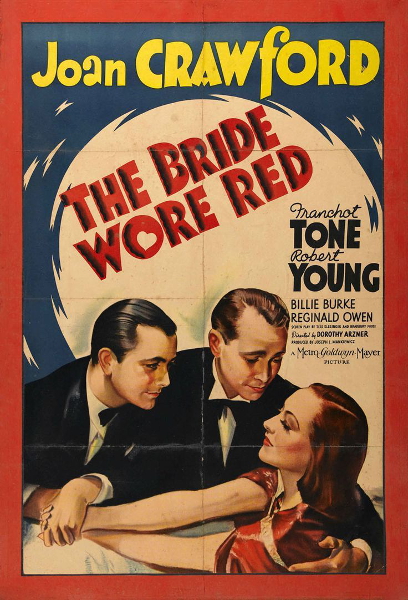

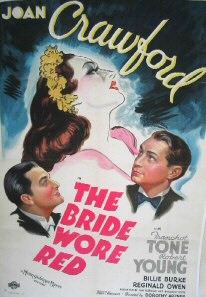
Below: US lobby cards.



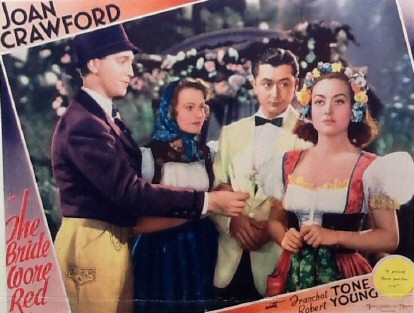
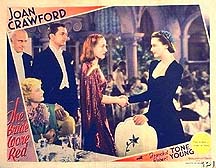
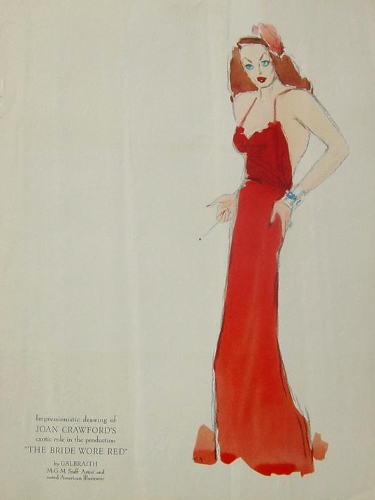
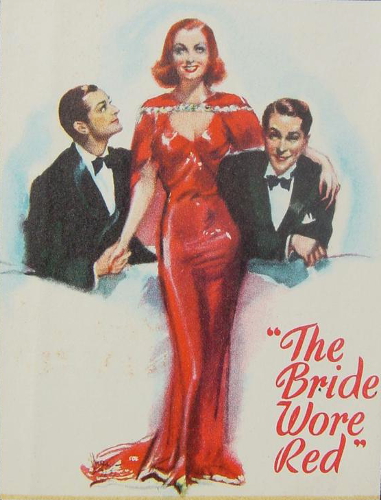
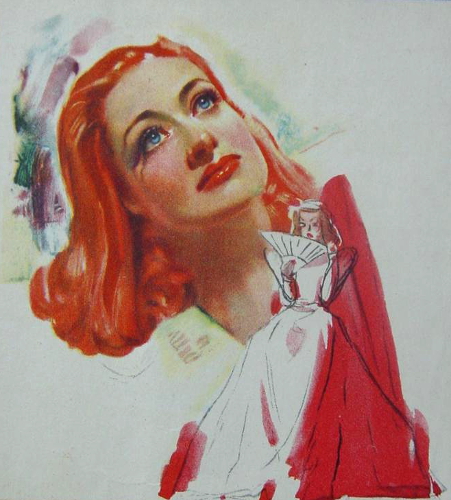
Above: MGM artwork.
Below: US herald.
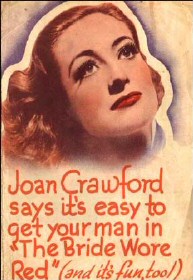

Below: US trade ads.

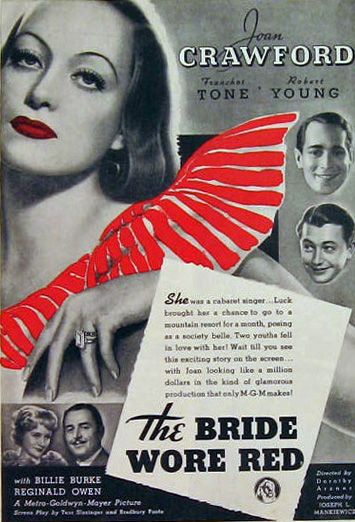
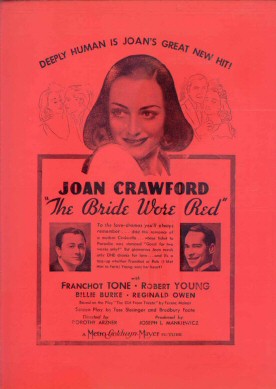
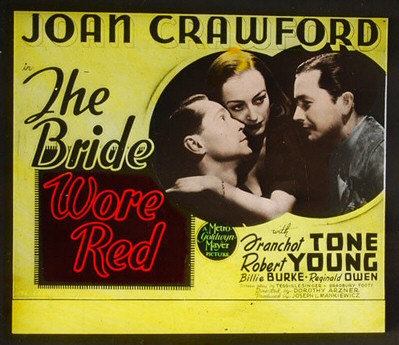
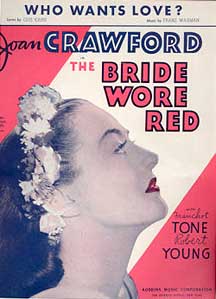
Above:
US glass slide, and US sheet music.
Below:
US newspaper ads (unknown and Pittsburgh, Kansas).
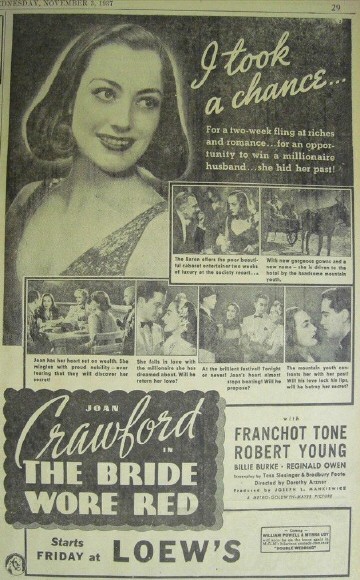

Below: UK newspaper ad.

Below: President Roosevelt in Poughkeepsie, NY, to lay post office cornerstone. With Joan 'Bride Wore Red' billboard as backdrop.
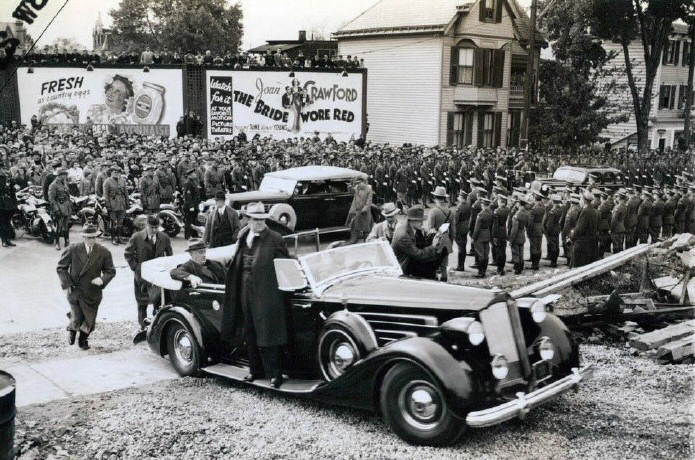
The Best of Everything